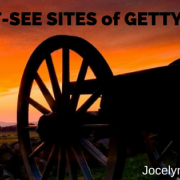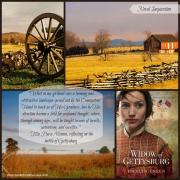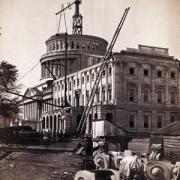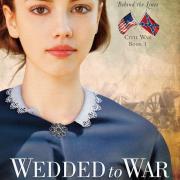9 Must-See Sites of Gettysburg
Gettysburg is one of my favorite spots on earth. I've visited to research for my novel Widow of Gettysburg, and then my husband and I went in 2013 for the 150th anniversary of the battle (and to celebrate our tenth wedding anniversary!).
For those of you considering a Gettysburg vacation (do it! do it!), check out this list of must-see sites I put together with the help of my readers and fellow history lovers. (If you have read Widow of Gettysburg, you'll be interested to know that almost all of the following were mentioned in the book.)
Explore
1. The Seminary Ridge Museum, housed in the original Lutheran Theological Seminary building. I had the privilege of seeing this museum the night before its grand opening, and I cannot say enough about it. If you only have time to see one "in-town" site, let it be this one.
[[{"type":"media", "view_mode":"media_large", "fid":"1255", "attributes":{"class":"media-image wp-image-3172", "typeof":"foaf:Image", "style":"", "width":"450", "height":"381", "alt":"The seminary building in 1863."}}]] The seminary building in 1863.
[[{"type":"media", "view_mode":"media_large", "fid":"1256", "attributes":{"class":"media-image wp-image-3173", "typeof":"foaf:Image", "style":"", "width":"450", "height":"601", "alt":"Seminary Ridge Museum today."}}]] Seminary Ridge Museum today.
2. The Shriver House Museum. I adored the Shriver House Museum! To get a full picture of Gettysburg in 1863, don't limit yourself to the battlefield. Or rather, realize the town itself was part of the battlefield. Confederate snipers fired from the attic of the Shriver House. The docents here are wonderful, and really bring the personal story of a Gettysburg family to life. The home of Hettie Shriver's neighbor, Tillie Pierce, is now an inn: The Tillie Pierce Inn.
[[{"type":"media", "view_mode":"media_large", "fid":"1258", "attributes":{"class":"media-image wp-image-3174", "typeof":"foaf:Image", "style":"", "width":"450", "height":"601", "alt":"Shriver House Museum"}}]] Shriver House Museum docent
3. Christ Lutheran Church. The church, used as a hospital during the battle, is usually open during the day. If at all possible, attend one their Saturday evening Songs and Stories of a Civil War Hospital performances. This was one of my most meaningful experiences at Gettysburg! Bring the kleenex.
[[{"type":"media", "view_mode":"media_large", "fid":"1260", "attributes":{"class":"media-image wp-image-3175", "typeof":"foaf:Image", "style":"", "width":"450", "height":"601", "alt":"Christ Lutheran Church. The red flag signifies its use as a hospital during and after the battle. (Most buildings in town had a red flag out front!)"}}]] Christ Lutheran Church. The red flag signifies its use as a hospital during and after the battle. (Most buildings in town had a red flag out front!)
4. The historic Gettysburg Train Station. This is the station Lincoln rode into to deliver his famous Gettysburg Address.
[[{"type":"media", "view_mode":"media_large", "fid":"1261", "attributes":{"class":"media-image wp-image-3177", "typeof":"foaf:Image", "style":"", "width":"450", "height":"326", "alt":"Photo courtesy Peggy Detweiler"}}]] Photo courtesy Peggy Detweiler
5. The Jennie Wade House. Jennie Wade was the only civilian killed during the battle. (Many more were killed in its aftermath, from contaminated water, exploding shells, etc.)
[[{"type":"media", "view_mode":"media_large", "fid":"1262", "attributes":{"class":"media-image wp-image-3178", "typeof":"foaf:Image", "style":"", "width":"450", "height":"338", "alt":"The Jennie Wade House"}}]] The Jennie Wade House
6. The David Wills House is a National Park Service museum which tells the story of David Wills (a Gettysburg lawyer), Lincoln, and the Gettysburg Address.
[[{"type":"media", "view_mode":"media_large", "fid":"1263", "attributes":{"class":"media-image wp-image-3180", "typeof":"foaf:Image", "style":"", "width":"450", "height":"337", "alt":"davidwills"}}]] The David Wills House
7. Evergreen Cemetery, which is adjacent to the National Cemetery. The monument to the Gettysburg Address is in the National Cemetery, but the location of the speech was actually in Evergreen Cemetery. Evergreen Cemetery is the burial place for Elizabeth Thorn, Rev. Schmucker, Jennie Wade, and others.
[[{"type":"media", "view_mode":"media_large", "fid":"1264", "attributes":{"class":"media-image wp-image-3179", "typeof":"foaf:Image", "style":"", "width":"450", "height":"338", "alt":"Monument to Elizabeth Thorn, the pregnant gravedigger, in Evergreen Cemetery."}}]] Monument to Elizabeth Thorn, the pregnant gravedigger, in Evergreen Cemetery.
8. Experience the Gettysburg National Cemetery with a free walking tour courtesy of licensed battlefield guides.
[[{"type":"media", "view_mode":"media_large", "fid":"1265", "attributes":{"class":"media-image wp-image-3181", "typeof":"foaf:Image", "style":"", "width":"450", "height":"300", "alt":"Sunrise at Soldiers National Cemetery, by Bill Dowling."}}]] Sunrise at Gettysburg National Cemetery, by Bill Dowling.
9. National Military Park and Battlefield
Start with the National Park Service Museum & Visitor Center. It's new since 2012, and features the restored, and famous, Gettysburg Cyclorama.
Ranger Programs range from battle history to medical practices of the Civil War, "Visit to the Past" living history presentations, and battlefield hikes. Programs are offered at the Museum and Visitor Center, on the battlefield, and in the Soldiers' National Cemetery, with lengths between twenty minutes and two hours depending on the subject matter and location. Special programs and activities are also available for kids.
Living History events are so much fun. Check this schedule of events page to find out what's happening when.
My family (and many others!) really enjoyed the audio auto tour, but there are several ways to tour. "We actually LOVED the driving tour (CD that plays in the car) that is offered through the museum! I think it was our favorite activity because it was educational, not hard on the little ones and we felt like we got an amazing overview of the town and war simultaneously!"~April Lakata
[[{"type":"media", "view_mode":"media_large", "fid":"1266", "attributes":{"class":"media-image wp-image-3183", "typeof":"foaf:Image", "style":"", "width":"501", "height":"501", "alt":"Pics from our auto tour! So much fun."}}]] Pics from our auto tour! So much fun.
"I love wandering around Gettysburg and trying to get off the beaten path. I like the equestrian statue of General James Longstreet in Pitzer Woods [below], notice the trail ride in the background. If you look close you can see where people have left coins on Hero's raised hoof." ~Peggy Detweiler (Check out the horseback riding trails.)
[[{"type":"media", "view_mode":"media_large", "fid":"1267", "attributes":{"class":"media-image wp-image-3184", "typeof":"foaf:Image", "style":"", "width":"450", "height":"447", "alt":"Photo courtesy of Peggy Detweiler"}}]] Photo courtesy of Peggy Detweiler
Favorites sites of the battlefields include Little Round Top, the Wheat Field, the High Water Mark, Devil's Den, and a multitude of monuments.
[[{"type":"media", "view_mode":"media_large", "fid":"1268", "attributes":{"class":"media-image wp-image-3185", "typeof":"foaf:Image", "style":"", "width":"450", "height":"600", "alt":"Meghan Gorecki perched atop Little Round Top."}}]] Meghan Gorecki perched atop Little Round Top.
[[{"type":"media", "view_mode":"media_large", "fid":"1269", "attributes":{"class":"media-image wp-image-3186", "typeof":"foaf:Image", "style":"", "width":"450", "height":"338", "alt":"My husband Rob at Devil"}}]] My husband Rob at Devil's Den.
Before you go, be sure to check out Gettysburg's Events Calendar to see what's happening! Enjoy your visit, and please send me a photo or post one to my Facebook page! I LOVE seeing my reader friends in Gettysburg! If you've already been to Gettysburg, what were some of your trip highlights?




